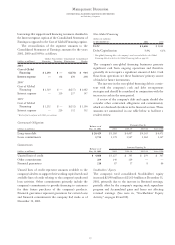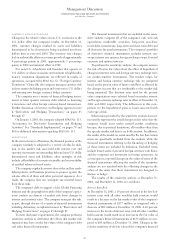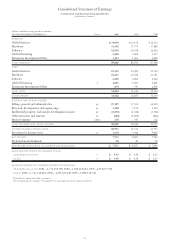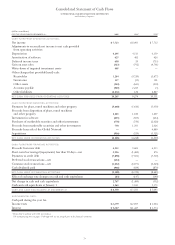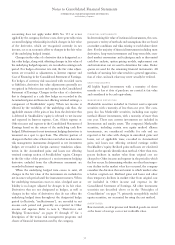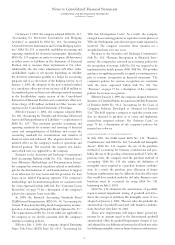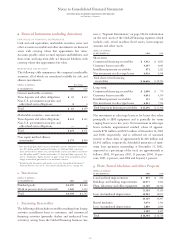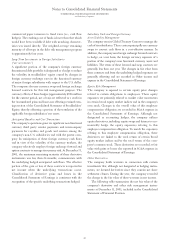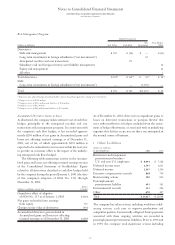IBM 2001 Annual Report Download - page 79
Download and view the complete annual report
Please find page 79 of the 2001 IBM annual report below. You can navigate through the pages in the report by either clicking on the pages listed below, or by using the keyword search tool below to find specific information within the annual report.
Notes to Consolidated Financial Statements
INTERNATIONAL BUSINESS MACHINES CORPORATION
and Subsidiary Companies
77
One of the principal components of the net periodic pen-
sion calculation is the expected long-term rate of return on
plan assets. The required use of expected long-term rate of
return on plan assets may result in recognized pension
income that is greater or less than the actual returns of those
plan assets in any given year. Over time, however, the
expected long-term returns are designed to approximate the
actual long-term returns and therefore result in a pattern of
income and expense recognition that more closely matches
the pattern of the services provided by the employees.
Differences between actual and expected returns are recog-
nized in the net periodic pension calculation over five years.
The company uses long-term historical actual return
information, the mix of investments that comprise plan
assets, and future estimates of long-term investment returns
by reference to external sources to develop its expected
return on plan assets.
The discount rate assumptions used for pension and non-
pension postretirement benefit plan accounting reflects the
rates available on high-quality fixed-income debt instruments
on December 31 of each year. The rate of compensation
increase is another significant assumption used in the actuarial
model for pension accounting and is determined by the
company based upon its long-term plans for such increases.
For retiree medical plan accounting, the company reviews
external data and its own historical trends for health care
costs to determine the health care cost trend rates.
INCOME TAXES
Income tax expense is based on reported income before
income taxes. Deferred income taxes reflect the effect of
temporary differences between asset and liability amounts
that are recognized for financial reporting purposes and the
amounts that are recognized for income tax purposes. These
deferred taxes are measured by applying currently enacted
tax laws. Valuation allowances are recognized to reduce the
deferred tax assets to an amount that is more likely than not
to be realized. In assessing the likelihood of realization,
management considers estimates of future taxable income.
TRANSLATION OF NON-U.S. CURRENCY AMOUNTS
Assets and liabilities of non-U.S. subsidiaries that operate in
a local currency environment are translated to U.S. dollars at
year-end exchange rates. Income and expense items are
translated at weighted-average rates of exchange prevailing
during the year. Translation adjustments are recorded in
Accumulated gains and losses not affecting retained earnings
within Stockholders’ equity.
Inventories, Plant, rental machines and other property
—
net, and other non-monetary assets and liabilities of non-U.S.
subsidiaries and branches that operate in U.S. dollars, or
whose economic environment is highly inflationary, are
translated at approximate exchange rates prevailing when
the company acquired the assets or liabilities. All other assets
and liabilities are translated at year-end exchange rates. Cost
of sales and depreciation are translated at historical exchange
rates. All other income and expense items are translated at
the weighted-average rates of exchange prevailing during
the year. Gains and losses that result from translation are
included in net income.
DERIVATIVES
In the normal course of business, the company uses a variety
of derivative financial instruments to manage currency
exchange rate and interest rate risk. The company does not
use derivatives for trading or speculative purposes, nor is it a
party to leveraged derivatives.
All derivatives are recognized on the balance sheet at fair
value and are reported in Prepaid expenses and other current
assets, Investments and sundry assets, Other accrued
expenses and liabilities or Other liabilities in the Consolidated
Statement of Financial Position. Classification of each deriva-
tive as current or non current is based upon whether the
maturity of each instrument is less than or greater than
12 months. To qualify for hedge accounting in accordance
with SFAS No. 133, “Accounting for Derivative Instruments
and Hedging Activities,” the company requires that the
instruments are effective in reducing the risk exposure that
they are designated to hedge. For instruments that are asso-
ciated with the hedge of an anticipated transaction, hedge
effectiveness criteria also require that it be probable that the
underlying transaction will occur. Instruments that meet
established accounting criteria are formally designated as
hedges at the inception of the contract. These criteria
demonstrate that the derivative is expected to be highly
effective at offsetting changes in fair value of the underlying
exposure both at inception of the hedging relationship and
on an ongoing basis. The assessment for effectiveness is
formally documented at hedge inception and reviewed at
least quarterly throughout the designated hedge period.
The company applies hedge accounting in accordance
with SFAS No. 133, whereby the company designates each
derivative as a hedge of (1) the fair value of a recognized asset
or liability or of an unrecognized firm commitment (“fair
value” hedge); (2) the variability of anticipated cash flows of
a forecasted transaction or the cash flows to be received or
paid related to a recognized asset or liability (“cash flow”
hedge); or (3) a hedge of a long-term investment (“net invest-
ment” hedge) in a foreign operation. From time to time,
however, the company may enter into derivatives that eco-
nomically hedge certain of its risks, even though hedge


